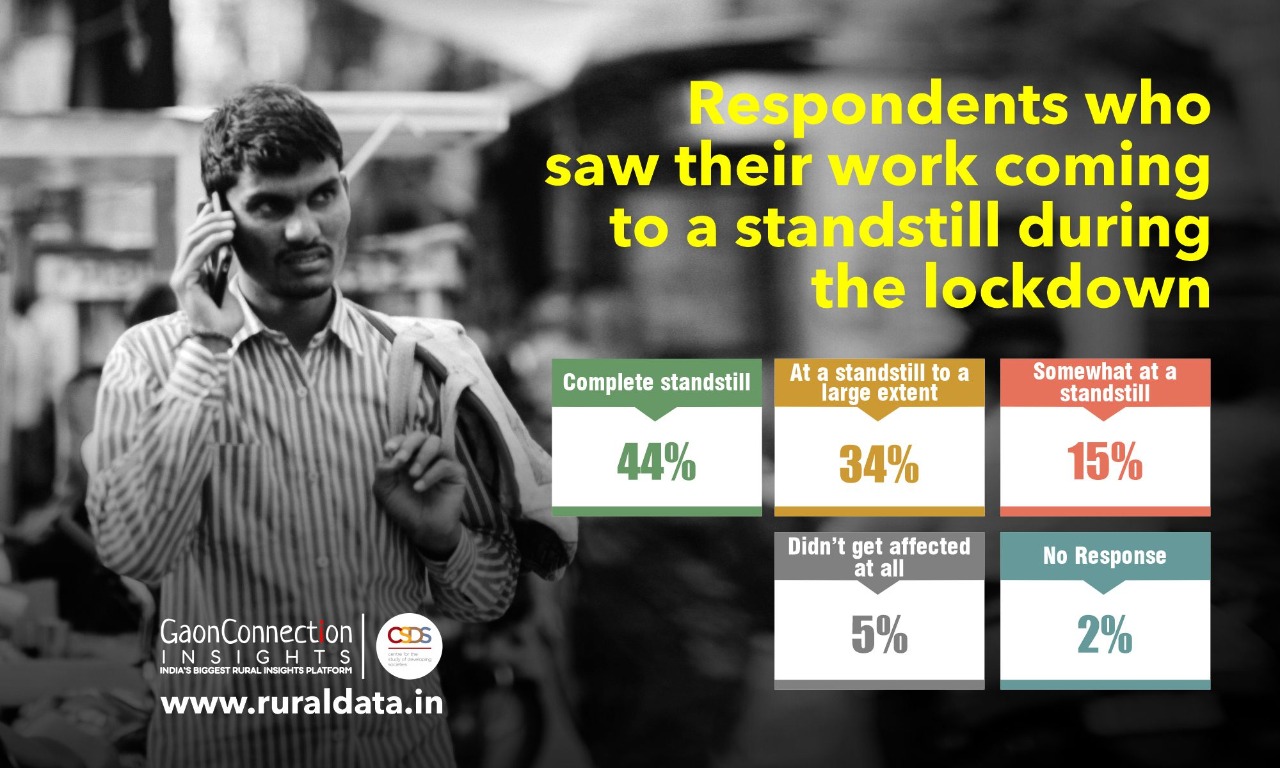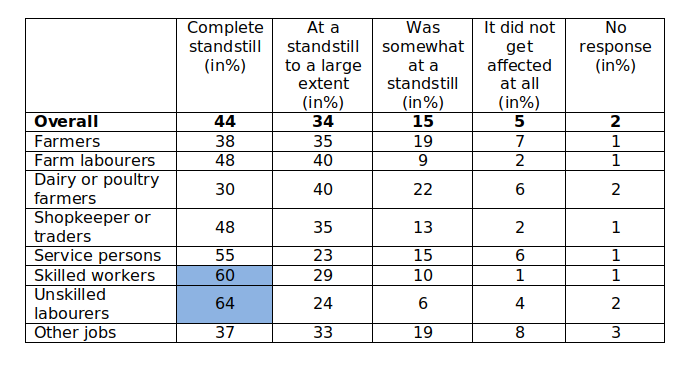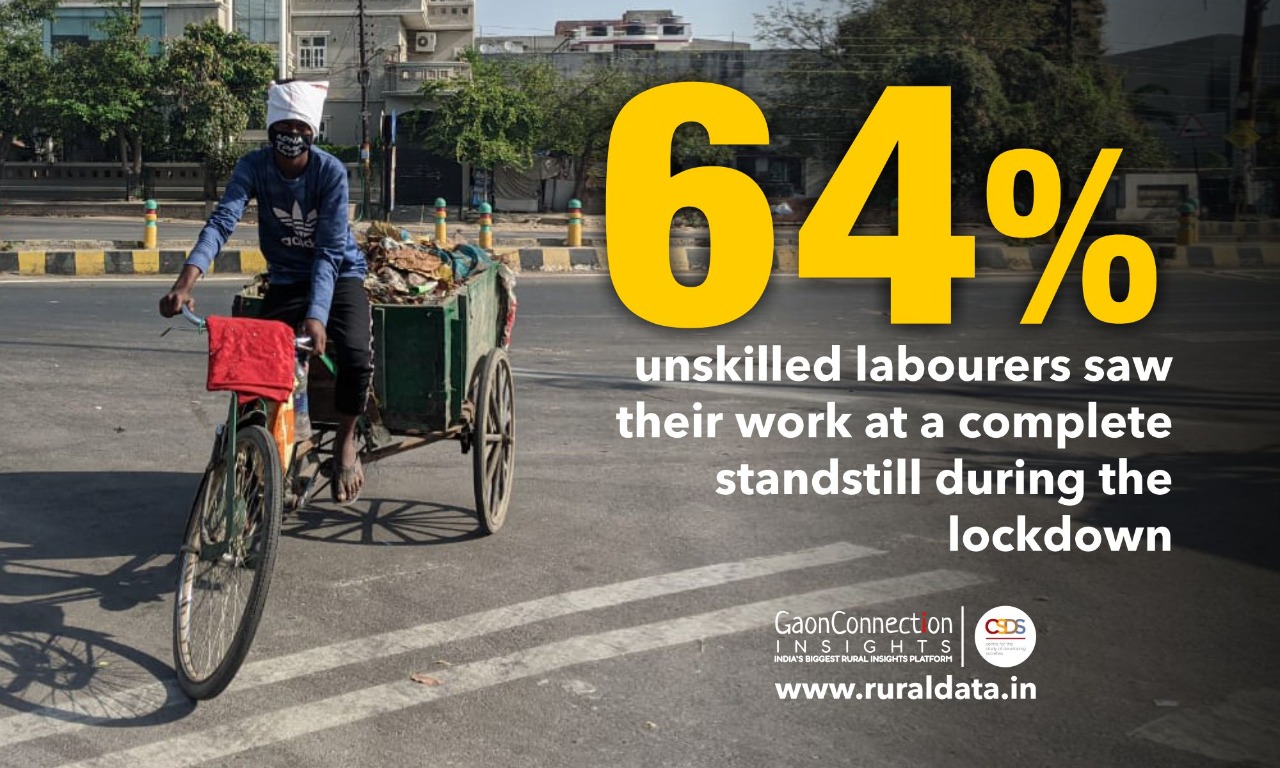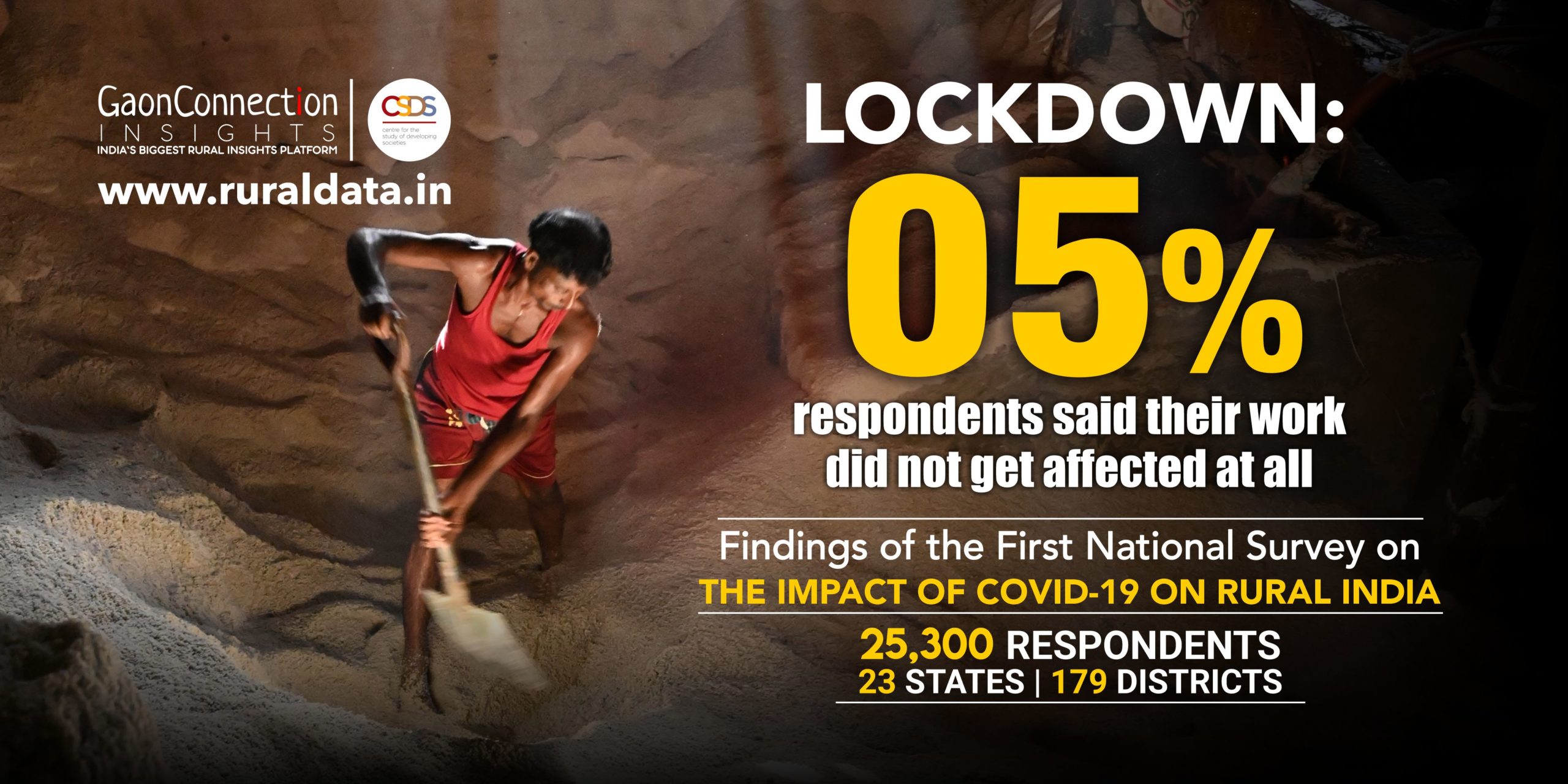80% rural respondents said their work was affected due to the lockdown
The recent lockdown created unforeseen havoc affecting millions of Indians. Every class of worker was hit hard – farmers, shopkeepers, weavers, cottage industry workers and the salaried class.

Mohammad Javed, a weaver from Prime Minister Narendra Modi’s Parliamentary constituency of Varanasi, feels dejected and defeated. His two handloom machines are lying idle for want of work. The recent lockdown due to the corona virus pandemic has hit him hard, as it has millions of others in the country.
“I have so far incurred a debt of Rs 35,000 after borrowing from relatives to run my household,” Javed, who weaves exquisite Banarsi sarees, told Gaon Connection, “I do not know when I can repay it. I had hoped to get a few orders during the relaxation in lockdown but I had hoped in vain,” Javed said. During the lockdown the unemployed weaver could not earn anything to feed his family two square meals.
Javed is not alone. An extensive national survey by Gaon Connection found that 8 out of 10 people did not have any work during the lockdown. Work completely stopped for 44 per cent of the respondents whereas that of 34 per cent of the people was largely affected. Combining the two, the livelihood of 78 per cent people was affected to a great degree, according to the survey. Fifteen per cent said their work remained closed only for a few days while 5 per cent of the people said their work was unaffected. 2 per cent of the respondents did not answer the question.

Gaon Connection conducted a countrywide survey to understand the impact of the COVID-19 lockdown on normal life and business in rural areas and how people managed their livelihood in these times. The national survey was conducted between May 30 and July 16, 2020.
The lockdown affected a slew of industries across India leaving millions of workers without work. It impacted the local cottage industry, such as Banarasi and Chanderi saree industry, employing thousands of people in their home districts, garment industries at Mumbai and Noida, auto parts industry at Manesar in Haryana, Jamshedpur and Bokaro in Jharkhand, brass industry of Mirzapur and the famous glass industry in Firozabad.
Besides the factory workers, the daily wage earners and construction workers were also hit by the lockdown.
The survey, based on face-to-face detailed interviews was carried out in 179 districts across 20 states and three Union Territories by Gaon Connection Insights, the data and insights arm of India’s largest rural media platform. The survey was designed and data analysed by the New Delhi-based Centre for Study of Developing Societies (Lokniti-CSDS).
The states where the survey was conducted included Rajasthan, Punjab, Haryana, Himachal Pradesh, Uttarakhand, Bihar, Uttar Pradesh, Jharkhand, West Bengal, Sikkim, Assam, Arunachal Pradesh, Manipur, Tripura, Odisha, Kerala, Maharashtra, Gujarat, Madhya Pradesh and Chandigarh, besides, the survey was also conducted in Jammu and Kashmir, Ladakh, Andaman and Nicobar Islands.

Ashok Mangauli of Dhaleshwar village in Nimpara block of Puri district of Odisha, who had a kirana (grocery) store, said he had to shut down his shop as his business had brutally suffered during the lockdown. “I do not have money to resume it. I had grown some vegetables but I could not sell them as the government mandis remained closed, whatever I could sell was at a throwaway rate,” he lamented.
The survey found that 38 per cent of the farmers were totally affected by the lockdown, while 34 per cent of the farmers were affected to some extent. 15 per cent said the lockdown impacted them for a limited period of time whereas five per cent of the farmers said their work continued as before. One per cent did not respond.

Among those surveyed, farmers formed the largest category with 6,783 (26.7 per cent) of the respondents. There were also 5,037 (20 per cent) agricultural labourers, 2,572 (10 per cent) were shopkeepers and traders, 429 (2 per cent) were associated with dairy, 484 (2 per cent) were related to service, 801 (3 per cent) were engaged in skilled work, 2,395 (9 per cent) were unskilled and 25 per cent (6,387) were doctors, teachers and those working in government and private offices.
The lockdown affected both skilled and unskilled workers.
Sixty per cent of the skilled and 64 per cent of the unskilled workers said their work was totally affected during the lockdown, while 29 per cent skilled and 24 per cent unskilled said they had been affected a bit. Ten per cent of the skilled and 6 per cent of the unskilled worker said the impact had been for some time, while 1 per cent and 4 per cent respectively believed that the lockdown did not affect them at all. 4 per cent skilled and 2 per cent unskilled workers refused to comment.

“For three generations, my family has been making sweets (khurchan). After Baba Ji (grandfather), my father did this work and thereafter I took over this business which completely closed in the lockdown. I am barely able to eke out a living,” Chandramani Mishra, 50, from Satna district, Madhya Pradesh told Gaon Connection.
Dasaiyya Basore, an artisan from Satna district, said the lockdown had totally ruined his livelihood. “I sold bamboo items for the last 35 years and earned Rs 400 to Rs 500 daily. During the lockdown I couldn’t sell even one basket,” he lamented.
The lockdown also impacted agricultural labourers. Forty eight per cent said they were totally affected while 35 per cent were affected to some extent. 19 per cent of the workers were affected for a limited time and 7 per cent said they were not impacted. One per cent did not respond.
In the dairy and poultry business, 30 per cent said their work was completely shut down, while 40 per cent said they were somewhat affected. Twenty two per cent said they were affected only for a few days, 6 per cent suffered no impact and 2 per cent did not respond.
Businesses of 48 per cent of the surveyed shopkeepers and small entrepreneurs were completely closed, while 35 per cent said they had been somewhat affected. Thirteen per cent said their work was closed only for a few days. The lockdown did not impact 2 per cent while one per cent did not respond.

Jitender Lakhera operates a general store in Mahoba district, 230 kms from Uttar Pradesh capital of Lucknow said, “I wanted a loan to pay the rent of my shop during lockdown. The government did not help people like us. Although the government says it will give loans to small traders, the banks refuse.” “We we could barely manage to buy food to eat,” he added.
The salaried class too was affected by the lockdown, the survey found. Fifty five per cent of the people said their work was completely closed, while 23 per cent were somewhat affected and 15 per cent said their work had been affected only for a limited time. 6 per cent of the people had worked throughout the lockdown whereas 1 per cent did not respond.
Of other occupations that could not be put under any category, 37 per cent of the people believed that their work was completely affected in the lockdown and 33 per cent said they were impacted only to some extent while 19 per cent of the people said their work was affected for a limited period. Four per cent of the people saw no impact while one per cent declined to comment.
The brassware industry of Mirzapur district, adjoining Varanasi, which had an annual turnover of crores of rupees, is currently on the brink of closure.
“Brass utensils have now gone out of fashion. Still, during April, May and June, we earned well because of marriages and it used to see us through the year. The lockdown ruined our earning season, we couldn’t earn even to sustain ourselves,” rued brass worker Makkhan Singh.

